Stabilizing hypoxia-inducible factor manage anemia in chronic kidney disease:From basic theory to clinical study
IF 3.1
4区 医学
Q1 UROLOGY & NEPHROLOGY
引用次数: 0
Abstract
Background: Anemia is one of the common complications of chronic kidney disease (CKD), and its prevalence has been arising globally. The key cause of anemia in CKD patients is the diseased kidney's reduced ability to synthesize endogenous erythropoietin, yet this is not the sole reason. Inflammatory elements, functional iron deficiency, and uremic toxins together participate in the development of anemia. According to research data, anemia is an independent risk factor for cardiovascular events, all-cause mortality and worsening renal function, and affects the clinical prognosis and quality of life of CKD patients. Regular treatments for anemia in CKD patients include the use of erythropoietin stimulators (ESA), iron supplements, and blood transfusions. Summary:Hypoxia-inducible factor prolyl hydroxylase inhibitors (HIF-PHIs) is a novel and small molecule pharmacological compound that targets the HIF pathway and is another option for improving anemia in CKD patients. HIF-PHIs simulates hypoxia, stabilizes HIF protein, stimulates EPO synthesis, reduces hepcidin level and boosts iron utilization, induces the creation of red blood cells and alleviates anemia. The results of several HIF-PHIs phase III trials indicated that HIF-PHIs are similarly effective as ESA at raising hemoglobin (Hb) concentration. Key Messages: This article summarizes the structure of HIF and the mechanism of stabilizing HIF to improve anemia, discusses the efficacy of HIF-PHIs in CKD patients with or without dialysis, as well as emphasizes the potential safety concerns with HIF-PHIs.稳定低氧诱导因子管理慢性肾脏病贫血:从基础理论到临床研究
背景:贫血是慢性肾脏病(CKD)的常见并发症之一,其发病率在全球范围内不断上升。CKD 患者贫血的主要原因是病变肾脏合成内源性促红细胞生成素的能力下降,但这并不是唯一的原因。炎症因素、功能性缺铁和尿毒症毒素共同参与了贫血的发生。研究数据显示,贫血是心血管事件、全因死亡率和肾功能恶化的独立危险因素,并影响慢性肾脏病患者的临床预后和生活质量。慢性肾脏病患者贫血的常规治疗包括使用促红细胞生成素(ESA)、铁补充剂和输血。摘要:缺氧诱导因子脯氨酰羟化酶抑制剂(HIF-PHIs)是一种新型的小分子药理化合物,以 HIF 通路为靶点,是改善 CKD 患者贫血的另一种选择。HIF-PHIs 可模拟缺氧状态,稳定 HIF 蛋白,刺激 EPO 合成,降低血钙素水平,促进铁的利用,诱导红细胞生成,缓解贫血。几项HIF-PHIs III期试验结果表明,HIF-PHIs在提高血红蛋白(Hb)浓度方面的效果与ESA相似。关键信息:本文概述了 HIF 的结构和稳定 HIF 以改善贫血的机制,讨论了 HIF-PHIs 在接受或不接受透析的 CKD 患者中的疗效,并强调了 HIF-PHIs 潜在的安全性问题。
本文章由计算机程序翻译,如有差异,请以英文原文为准。
求助全文
约1分钟内获得全文
求助全文
来源期刊

Kidney Diseases
UROLOGY & NEPHROLOGY-
CiteScore
6.00
自引率
2.70%
发文量
33
审稿时长
27 weeks
期刊介绍:
''Kidney Diseases'' aims to provide a platform for Asian and Western research to further and support communication and exchange of knowledge. Review articles cover the most recent clinical and basic science relevant to the entire field of nephrological disorders, including glomerular diseases, acute and chronic kidney injury, tubulo-interstitial disease, hypertension and metabolism-related disorders, end-stage renal disease, and genetic kidney disease. Special articles are prepared by two authors, one from East and one from West, which compare genetics, epidemiology, diagnosis methods, and treatment options of a disease.
 求助内容:
求助内容: 应助结果提醒方式:
应助结果提醒方式:


